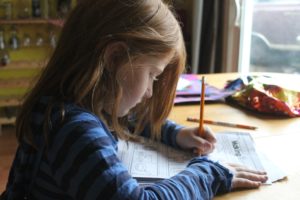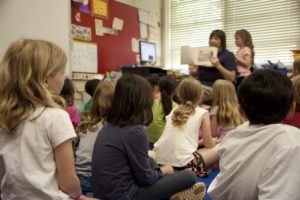
Addressing The Problem with Homework
Many educators are starting to recognize the problem with homework. And while homework is almost universal, there is little evidence that it actually works.

“Go look it up.” Anyone born before the year 2000 knows this as the standard response when a student asks a teacher what a word means. This phrase symbolizes an old-fashioned, curmudegeonly approach to teaching, where the adult seems to not be responding to the child’s learning needs.
In reality, though, the teacher is resisting the role of “information provider,” and empowering the student to drive her own learning. As the saying goes, “Give a man a fish, you feed him for a day; teach a man to fish, you feed him for his whole life.”
Much of today’s professional development is driven by efforts to create student-centered classrooms, where, rather than providing students with information, we use constructivist methods that empower students to explore and create their own meaning. Too often, though, PD comes in the form of “a lecture about why you shouldn’t lecture.” Instead we can use technology to help teachers teach themselves how to teach their students.
There are many reasons why we should empower students to guide their own learning to the degree that they are capable. The “content delivery” method of education, where a teacher lectures to provide students with information has its benefits: a passionate speaker can inspire students to take interest in a topic they would not otherwise care about; some students who are not fluent readers can benefit from having material delivered orally.
The limitations of lecture, though, have been well-documented: it is too easy for students to disengage from a lecture; information must be targeted to the ‘middle’ student, leaving out students who are ahead or behind; and basic cognitive psychology asserts that learning by doing leads to deeper understanding and better retention. In an article in Science magazine, Aleszu Bajak examines research that shows students are just not learning as much as they could be when we lecture. Shelley Wright delivers a great TEDx talk about the dramatic benefits she witnessed when she made the switch from a lecture-based to a student-centered classroom.
It’s ironic, of course, that organizations, like TED, that promote progressive education, are done in a lecture-based format. The main difference is that we are getting the opportunity to hear from a top expert in the world about the most important thing they have to say, in 18 minutes or less. My favorites are Dan Meyer’s “Math Class Needs a Makeover” and Sir Ken Robinson’s “Do Schools Kill Creativity?” I’ve watched these talks many times over several years, and I’m constantly unpacking and applying the information and philosophy contained in these short lectures. How many of us have even 18 minutes of insight to share as powerful as these talks? A good lecture is written, revised, and rehearsed until it becomes a paragon of inspiration, poignancy, and clarity. Unless we’re prepared to provide this level of quality to our students on a daily basis, we really need to consider alternatives.
Of course, simply telling teachers to ‘ditch the lecture’ is not a transformative approach. Telling people what not to do is easy; finding, clarifying, and supporting an alternative is where the real challenge lies. If we want to help teachers take a student-centered approach to educating their students, it is important to model student-centered teaching in professional development. In his Edutopia article, “Student-Centered Learning: It Starts with the Teacher,” John McCarthy explains that allowing students to share in decision-making and believing in their capacity to lead are essential components in creating a student-centered classroom. If we truly believe in these principles, we need to be very careful about lecture-based PD, especially when targeted at a “general” audience that includes dozens or even hundreds of teachers, all of whom may have different experience, interests, and goals.
This is why Personal Learning Networks are so important. As a grad student, I had an assignment to create a Twitter account and send ten tweets. At first, I thought it was kind of silly – did I really need to know what Kim Kardashian had for breakfast? I soon began realizing that Twitter was a place to cultivate your own experience – it takes some work to get started, but now that I’m following innovators and educators who have interesting things to say, Twitter has become a place for me to hear about amazing ideas and events that are geared to my interest in education technology.
The idea of Personal Learning Networks really came together for me when Karen Blumberg spoke at a blended learning workshop I was facilitating. The workshop had already been planned to emphasize group work time and include a few short presentations. Karen had agreed to speak informally at lunch one day. She chose to discuss online PLNs, and that’s when I realized that all of the online tools I was using (Twitter, podcasts, blogs, discussion boards) weren’t just to access information – they were about creating communities and opportunities for all of us to learn from each other in a grassroots fashion. I also realized that in order to disrupt education, it wasn’t enough to be involved in PLNs, we have to help them grow by showing teachers how to cultivate their own learning communities and drive their own professional development. Here are some of my favorite tools for cultivating a PLN:
Twitter: Next time you come across an interesting video or article, follow the author/speaker on Twitter – soon you’ll have access to a steady stream of articles and ideas tailored to your interest.
Pinterest: I started using Pinterest as a way to share articles with colleagues as we planned a PD session. (I didn’t realize at the time that most people saw it as an arts and crafts site). I maintain two pages where I post my favorite articles on Blended Learning Philosophy and Curriculum Development, and one where I post my favorite Blended Learning Tools.
EdCamp: EdCamp is the gold standard for PLNs. Events are free, teacher-driven PDs. The agenda is determined on the day of the event and participants can facilitate or participate in discussions on any topic they choose. If there is one in your area, find a way to get there.
PodCasts: You can’t read all the time. Pick any topic you’re interested in, type it into Google with the word ‘podcast,’ and you’re bound to find something. Use iTunes or a slightly fancier app like iCatcher to subscribe to a few podcasts that speak to your interest, and you’ll be engaging in professional development on your daily commute. TEDTalks Education and Angela Watson’s Truth for Teachers are two of my favorites.
Blogs: If you’re reading this, I’ll assume you’re already familiar with this one.
The best part is that once you get involved in a PLN, you can easily make the shift from consumer to producer by tweeting, pinning, blogging, podcasting, and facilitating.
Have you cultivated your own Personal Learning Network? Do you think they’re the future of professional development? Get in touch and tell us about it!

Many educators are starting to recognize the problem with homework. And while homework is almost universal, there is little evidence that it actually works.

Does the Danielson Rubric improve teaching? Maybe it’s an unfair question. After all, it’s a rubric, not a training program. But…

Looking for a simple way to identify effective teaching? Consider how you (or your team) are performing in each of these three critical domains.